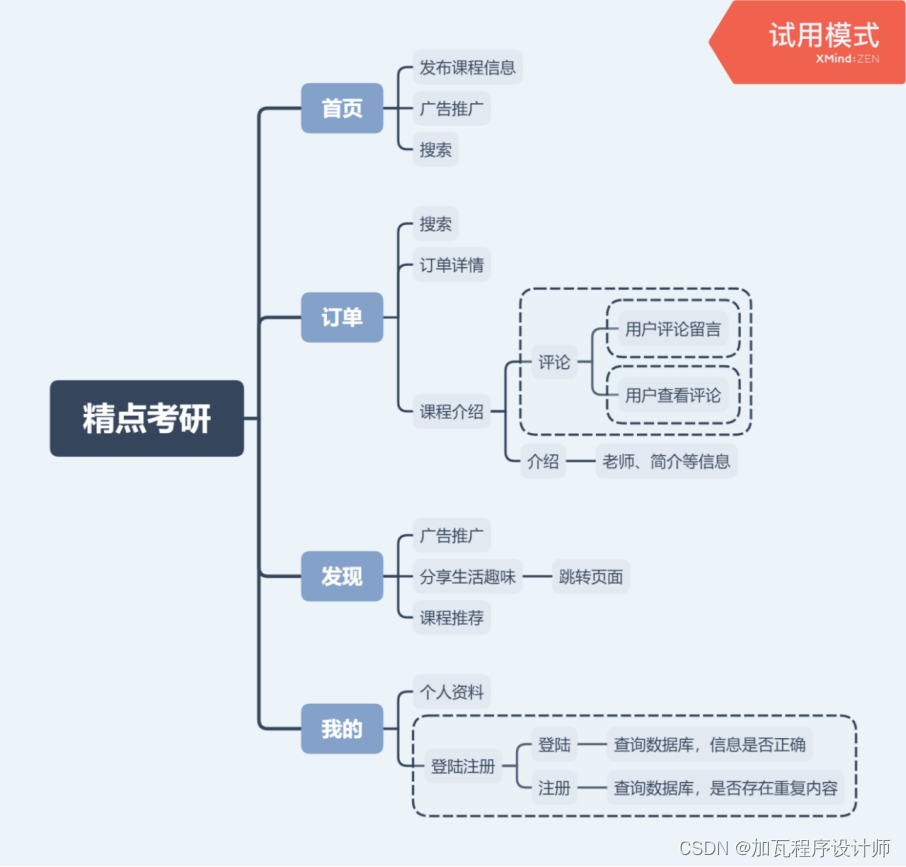【考研英语语法】状语从句精讲
【考研英语语法】状语从句精讲
一、状语从句概述
(一)状语从句的含义
- 状语从句,指的就是一个句子作状语,表达“描述性的信息”,其副词作用,可以修饰谓语、非谓语动词、定语、状语或整个句子。
- 描述性的信息有很多种,可以描述时间、地点、原因、结果、条件、目的、让步、方式和比较,共九类。
- 状语从句一般由从属连词引导,也可以由词组引起
- When you love me, l will love you. 当你爱我时,我就会爱你。 时间
- Wherever you go, l will go. 无论你去哪里,我都会去。 地点
- l love you because you love me. 我爱你,因为你爱我。 原因
- l will love you if you love me. 如果你爱我,我就会爱你。 条件
- l love you in order that you will love me. 我爱你是为了让你爱我。 目的
- l love you so that you will love me. 我爱你,这样你就会爱我。 结果
- Although you don’ t love me, l still love you. 虽然你不爱我,但我仍然爱你。 让步
- l love you in the way that you love me. 我以你爱我的方式爱你。 方式
- l love you as much as you love me. 我爱你就像你爱我一样。 比较
(二)状语从句的写法
- 状语从句是所有从句中写法最简单的,状语从句的构成为:一个完整的陈述句前面再加上一个从属连词。这个“从属连词”是比较特别的一种连接词,不作句子成分,但表示一定的逻辑关系,用来说明这个状语从句是描述何种信息的。同时,状语从句的种类是由从属连词决定的,即从属连词表示什么含义(逻辑关系),那么从句就是什么状语从句。
- We did not evolve, because machines and society did it for us.
(三)状语从句的位置
-
状语从句既然是补充说明主句的,那它就要出现在主句周围,状语从句的位置通常有三种:主句前,主句后,主句中。同一个状语从句可以处于三种不同的位置,但意思相同。
-
1. 主句前
- As the economy picks up, opportunities will abound for aspiring leaders.
-
2. 主句后
- Opportunities will abound for aspiring leaders, as the economy picks up.
-
3. 主句中
- Opportunities, as the economy picks up, will abound for aspiring leaders.
二、状语从句的分类
- 状语从句表达描述性的信息,用来补充说明主句,共分为九种:时间状语从句、地点状语从句、原因状语从句、结果状语从句、目的状语从句、条件状语从句、让步状语从句、比较状语从句和方式状语从句。(其中加粗的五种为重点)状语从句的核心不在于后面的陈述句,而在于前面的从属连词。从属连词表达什么含义(逻辑关系),那么从句就是什么状语从句。换言之,状语从句的种类是由从属连词来决定的。
(一)时间状语从句
- 用表示时间的连词连接一个句子作状语,这样的主从复合句就是时间状语从句
- 引导时间状语从句的连词较多,主从句时态搭配以及谓语动词的动作时间长短性等用法特点也各不相同
- 引导时间状语从句的连接词包括:when、as、while、after、before、since、ever since、as soon as、once、till、until、whenever、no sooner … than,hardly / scarcely … when,the moment / minute / instant / second,every time,each time,any time,the first time,next time,last time,all the time,by the time,directly,immediately,instantly 等
时间状语从句连词: when
when 的意思相当于 at that time,表示 “在 … 时刻”。时间状语从句所表达的时间通常是过去和将来。
1. 主句一般过去时 + 从句一般过去时
- l started my dinner when he left.
- She left when l got there.
- 主从句都用一般过去时,则表示主句动作先发生。
2. 主句一般过去时 + 从句过去完成时
- l started my dinner when he had left.
- She left when l had got there.
- 从句用了过去完成时,更强调了从句动作先发生。
3. 主句一般过去时 + 从句过去进行时
- The doorbell rang when l was washing the dishes. 我在洗碗的时候,门铃响了。
这里的瞬时动作 rang 用一般过去时,延续动作 wash 用过去进行时。这个句子也可以换成 “主句过去进行时 + 从句一般过去时” 这样的时态搭配,具体用法需看句子是否合理。
4. 主句过去进行时 + 从句一般过去时
- l was washing the dishes when the doorbell rang.
由 “主句一般过去时 + when + 从句过去进行时 ”变成“ 主句过去进行时 + when + 从句一般过去时”,此时 when 的意思发生了改变,即由
during the time 变成了 at the time。这的 when 强调某个瞬时动作突然发生。
5. 主句一般将来时+从句一般现在时
在表示将来的动作时,主句显然要用一般将来时,而时间从句要用一般现在时表示将来,不能使用将来时态。
- l’ll speak to your supervisor when he arrives. 等你的上司来了,我再跟他说。
- I’ll tell your mom about it when she comes back. 你妈妈回来后我会告诉她的。
时间状语从句连词: while
当 while 用作时间连词时,意思相当于 during that time,表示某一时间段内发生的动作。因此,从句的谓语动词通常接延续性动词。
- l 'll keep you company while you’re waiting. 在你等待的时候,我会陪着你。
- Someone called while you were out. 你不在的时候有人打电话来。
- We must have been burgled while we were asleep. 我们一定是在睡觉时被盗了。
- while 除了作连词引导时间状语从句,也可以引导让步状语从句等,后面会提及。
时间状语从句连词: until
until 既可以用作介词也可以作为连词,所以 until 的后面可以接名词短语也可以接时间状语从句。使用时的本质思维是表示 “一个 (主句) 动作一直持续到某一个时间点”。既然是延续动作,那么 until 前面的主句或句子的谓语就必须是延续性的,而 until 后面接的从句的谓语则要是短暂性动词或接时间点。常用的方式有两种:
1. 作为连词时可引导从句
主句的延续动词 + until + 从句的瞬时动词
- You’ ll just have to wait until they call your name. 你只需等待,直到他们叫你的名字。
- l stayed there until he arrived. 我呆在那里直到他到达。
2. 作为介词接名词短语
延续动词 + until + 时间点(不能是时间段)
- She continued to get a salary until the end of June. 她继续拿着工资,直到6月底。
- Until 2004, she lived in Canada. 直到 2004 年,她一直住在加拿大。
当主句或句子的谓语动词是短暂动词,通常要用否定形式。瞬时动词否定之后表示的是一个状态,而状态是延续性质的。这也就是我们常用的 not…until 的结构,表示 “直到…才”。
- l did not wake up until l heard the alarm clock. 直到我听到闹钟的声音,我才醒过来。 (作连词)
- We did not notice this matter until yesterday. 我们直到昨天才注意到这件事。 (作介词)
- The heat did not relax until midnight. 直到午夜,热度才有所放松。 (作介词)
时间状语从句连词: as
1. as 引导时间状语从句意思类似 when,但较强调同时发生,多指短暂动作。
- We got to the check-in desk just as they were about to close. 我们到达登记处时,他们正准备关门。
2. as 可说明两种正在发展或变化的情况,表示 “随着…”,表达时间的推移。
- As l get older, l get more optimistic. 随着我年龄的增长,我变得更加乐观
- Another policeman has been injured as fighting continued this morning. 今天上午,随着战斗继续进行,又有一名警察受伤。
3. as 表 “一边…一边…”,引出伴随动作。
- He jumps as he goes along. 他边走边跳
4. 用以强调两个动作紧接着发生。
- As he was going out, it began to rain. 当他要出去时,天开始下雨了。
表示 “—…就…” 结构的时间连词
英文中有一些时间连词用来表达主句的动作和从句的动作相继发生,两者之间的时间间隔不长,相当于 “一.….就” 的意思。这里的主句和从句的谓语一般都是瞬时性动词。
1. 从句动作先于主句动作
这样的用法是说在从句动作发生之后,紧接着主句动作就发生了。表示这一时间关系的连词有:as soon as, once, the minute, the moment, the instant, immediately, directly 和 instantly 等等。这些连词的用法和句式结构是一样的,主从句时态一般一致。注意如果表示将来的动作,则主句用一般将来时,从句用一般现在时表示将来。
- The dogs ran off as soon as we appeared. 我们一出现,那些狗就跑开了。
- l came immediately l heard the news. 我一听到这个消息就马上赶来了。
- Don’t trust those who leave their friends the moment they get into difficulty. 不要相信那些一遇到困难就离开朋友的人。
- l went home directly l had finished work. 我一结束工作就回家了。
2. 主句动作先于从句动作
具体来说就是在主句动作发生之后,紧接着从句动作就发生了。表示这一类时间关系的连词有:hardly..when, scarcely...when 和 no sooner...than。这些连词的用法和句式结构是不一样的,从句时态一般也不一致。它们一般用来表示过去的动作,此时,主句多用过去完成时,且常倒装,从句用一般过去时。可与 as soon as 等从句、主句互换。
- No sooner had she said it than she burst into tears. = She burst into tears as soon as she had said it. 她刚说完就哭了起来。
- Hardly had the storm started when all the lights went out. 暴风雨几乎没有开始,所有的灯都熄灭了。
- Scarcely had the votes been counted, when the telephone rang. 票数刚统计完,电话就响了。



(二)地点状语从句
用表示地点的连词连接一个句子作状语,就是地点状语从句。地点状语从句通常是由 where, wherever 等引导,用来表达主句的动作发生的场所。地点状语从句通常的结构是 “where + 陈述句”。
地点状语从句不重要,只要根据 where 能判断它引导从句,表示地点即可。
- Please sit where l can see you. 请坐在我可以看到你的地方。
- Make a mark where you have any doubts or questions. 在你有任何疑虑或问题的地方做个标记。
- Wherever he went, he took his dog with him. 无论他去哪里,他都带着他的狗。
1. where 引导的地点状语从句有时具有抽象条件含义,可放在主句的前面。
- Where there is a will, there is a way. 有志者事竟成。
- Where there is life, there is hope. 留得青山在,不怕没柴烧。
- Where people were concerned, his threshold of boredom waslow. 涉及人的事情,他便极易感到厌烦。
2. where 引导从句有时也具有对比意味,从句也多置于主句之前,此时从句与主句在语义上可以形成对比的意味。
- Where most people saw nothing but a hardened(麻木不仁的) criminal, l saw a lonely and desperate man. 大多数人看到的只是一个顽固的罪犯,而我看到的却是一个孤独和绝望的人。

(三)原因状语从句
用表示原因的连词连接一个句子作状语,就是地点状语从句。英文中常用because, for, as 和 since 这四个连词来引导原因状语从句。
- l don’ t spend a lot of money just because I’m in a badmood. 我不会因为心情不好就花很多钱。
- Since we were in the area, we’d stop by and see them. 既然我们在这个地区,我们就顺便去看看他们
- As it was getting late, we decided to go home. 由于天色已晚,我们决定回家。
- Something fell in, for l heard a splash. 有东西掉进去了,因为我听到了溅起的水花。
在引导时间状语从句的连词中,because 的语气最强,只有它才能用来回答 why 的问句,表直接的因果关系,用于告知对方不知道的原因,所引出的原因往往是听话人所不知道的或很感兴趣的;也只有 because 才能被强调词如 only 和 just 等来修饰,可用于强调句。
- l did it because he told me to. 我这么做是因为他让我这么做。
- An argument was inevitable because they disliked eachotherso much. 争吵是不可避免的,因为他们非常不喜欢对方。
- Just because l don’t complain, people think l’m satisfied. 就因为我不抱怨,人们认为我很满意。
连词 because 用法
because 和 because of 的区别
because 是连词,引导从句;而 because of 是短语介词,后接名词性词语。
- The football match was put off because it rained. 因为下雨,足球比赛被推迟了。
- The football match was put off because of the rain. 由于下雨,足球比赛被推迟了。
连词 since 用法
since 语气比 because 稍弱,表示关系上的自然结果,引导原因状语从句多表示人们已知的事实,是不需要强调的原因,所以常翻译为 “既然,鉴于”,多数情况下放在句首。
- l’m forever on a diet, since l put on weight easily. 我一直在节食,因为我很容易发胖。
- Since there’’ s no more business, we can all go home. 既然没有业务了,我们都可以回家了。
- Since you have known the secret, l needn’t say anything about it. 既然你已经知道了这个秘密,我就不需要说什么了。
连词 as 用法
as 的用法和 since 差不多,语气比较弱,说明一般的因果关系,所引出的理由在说话人看来已经很明显,或这是已经为听话人所熟悉而不需用 because 加以强调。可放在主句之前,亦可放在主句之后。
- As it was getting late, we decided to go home. 由于天色已晚,我们决定回家。
- As you were out, l left a message. 你出去的时候,我留了个口信。
- She may need some help as she’s new. 她可能需要一些帮助,因为她是新人。
连词 for 用法
连词 for 表示推断的理由,不是说明直接原因,而是对某种情况加以推断,表示补充说明理由。而推断的理由会因人而异。语气很弱,它引出的分句必须放在另一分句后。
- He must be ill, for he is absent today. 他一定是生病了,因为他今天缺席。
- She began to grow nervous, for he had promised to meether at dawn. 她开始变得紧张起来,因为他已答应在黎明时分与她见面。
用介词表示因果关系
除了我们刚刚提到的 because of,常用的表示因果关系的介词还有 due to 和 owing to。因为是介词,所以其后面不能接从句,需要接名词。
-
because of:因为,由于
My laundry will not dry because of the humidity. 由于潮湿,我的衣服不会干 -
due to:因为,由于
He almost died due to lack of oxygen. 由于缺氧,他几乎死了。 -
owing to:因为,由于
Flights from the airport were cancelled owing to bad weather. 由于恶劣的天气,从机场起飞的航班被取消


(四)结果状语从句
- 结果状语从句是用来补充说明主句中谓语动词发生的结果的,一般位于主句之后。
- 常用的引导结果状语从句的连词有:so that, so…that 和 such…that
1. so that 表示 “因此,以至于”
- I’ll get a map so that we can plan where we’re going. 我去拿一张地图,这样我们就可以计划我们要去的地方。
- He lowered his voice so that no one would hear. 他压低声音,以免有人听到。
小提示:
so that 既可以引导目的状语从句(表示 “为了”),也可以引导结果状语从句(表示 “因此”)。当连接目的状语从句时,一般 that 从句中会含有情态动词,而引导结果状语从句时,大多不用情态动词
- l always get up early so that l can catch the first train. 我总是早起,这样我就能赶上第一班火车。 (目的状语从句)
- l got up early, so that l caught the first train. 我起得很早,这样我就能赶上第一班火车。 (结果状语从句)
2. so…that 表示 “如此…以至于”,so 后面接形容词或副词。
- The road surface became so hot that it melted. 路面变得非常热,以至于融化。
- They sat so close that their shoulders nearly touched. 他们坐得如此之近,以至于他们的肩膀几乎碰到了一起。
3. such…that 表示 “如此…以至于”,注意 such 后面接名词。
- He’ s such a good swimmer that he makes me look sick. 他是如此优秀的游泳运动员,以至于他让我看起来很恶心。
- He told us such funny stories that we all laughed. 他给我们讲了很多有趣的故事,我们都笑了起来。
将居中词语位置适当调整后, such…that 可以用 so…that 来替换,比如上面例子中第一句可以改为:
- He’ s so good a swimmer that he makes me look sick. 他是如此优秀的游泳运动员,以至于让我看起来很恶心。
4. 结果状语从句的倒装
such/so…that 引导结果状语从句,为了强调,还可以将主句中的 so 或 such 引导的部分置于句首从而构成倒装结构。
- So fast does light travel that it is difficult for us to imagine its speed. = Light travels so fast that it is difficult for us to imagine its speed. 光的传播速度如此之快,以至于我们很难想象它的速度。


(五) 目的状语从句
-
目的状语从句中一般都会含有情态动词
-
目的状语从句是指从句部分用以补充说明主句中谓语动词发生的目的的状语从句。
-
引导目的状语从句的从属连词主要有 in order that 和 so that,有时也会使用 in case, for fear。
-
目的状语从句的谓语中常含有 may, might, can, could, should, will, would 等情态动词。
1. so that 表示 “以便”
- She burned the letters so that her husband would never read them. 她烧掉了这些信,这样她的丈夫就不会读到这些信。
- He was standing in the shadow so that l could not see his face
clearly. 他站在阴影中,所以我看不清楚他的脸。
so that 引导目的状语从句时有时可省略 so 而只用 that
- The students climbed high (so) that they might get a better view. 学生们爬到了高处,以便他们可能会得到一个更好的视野。
- Bring it closer (so) that l might see it better. 把它拿近一点,以便我看得更清楚。
2. in order that 表示 “为了,以便”,用法相对比较正式
- ln order that we might get there on time, we should set out early. 为了使我们能按时到达那里,我们应该早点出发。
- l am saving money in order that l can buy a house. 我正在存钱,以便我可以买房子。
当主从句的主语一致时,in order that 连接的从句可以改为短语结构 in order to do
- Rick studied hard in order that he could pass the final exam.= Rick studied hard in order to pass the final exam. 为了通过期末考试,里克努力学习。
3. in case 表示 “以防”
- I’ll make some sandwiches, just in case we get hungry later on. 我会做一些三明治,以防我们以后饿了。 (目的状语从句,表示以防)
- ln case l forget, please remind me about it. 防止我忘记了,请提醒我。
注意 in case 可以引导目的状语从句,也可以引导条件状语从句,使用时要注意他们之间意义的差别。
- In case you should need any help, here’s my number. 如果你需要任何帮助,这是我的电话号码。
- In case you can’t come, give me a call before I leave for work. 如果你不能来,在我离开工作之前给我打个电话。
4. for fear that 表示 “以免,唯恐”
- He told us to keep quiet for fear that we might disturb others. 他让我们保持安静,以免担心我们会打扰别人。
- Shut the window for fear that it may rain. 关上窗户,生怕会下雨。
当主从句的主语一致时,for fear that 的从句结构可以改为 for fear of 的短语结构。
- we spoke quietly for fear that we should wake the guards.= We spoke quietly for fear of waking the guards. 我们悄悄地说话,生怕吵醒警卫。
目的状语从句一般位于主语之后,但若要强调目的状语从句,可将 so that 或 in order that 引导的从句置于句首
- ln order that my roommate could study in peace, l turned off the TV. 为了让我的室友能够安静地学习,我关掉了电视。

(六)条件状语从句
- 有时一个句子中会出现不止一个条件状语从句
- If you’re a physician, you can risk your patient’s suicide as long as you don’t intend their suicide. 如果你是一名医生,只要你不打算让病人自杀,你就可以冒着病人自杀的风险。
- 条件状语从句是由引导词 if 以及 unless 等词引导的状语从句。
- “条件” 是指某一件事情实现之后(状语从句中的动作),其它事情 (主句中的动作) 才能发生,通常译为 “假如”、“如果”
if 引导条件状语从句
引导条件状语从句最常用的连词是 if,表示 “如果”。常见的 if 条件状语从句表示在某条件下,某事很可能发生
1. 主句一般现在时,从句一般现在时
表示科学常识,经常性的动作,倾向,自然会发生的事。
- lf water is heated, it turns to steam. 如果水被加热,它会变成蒸汽。
- lf people don’ t get enough sleep, their thinking ability is reduced. 如果人们没有得到足够的睡眠,他们的思维能力就会下降。
2. 主句一般将来时,从句一般现在时
表示将来的可能性,包括能力、允诺、命令、要求、请求、建议等语气。
- lf my homework is difficult, I’ ll ask Bailey to help me. 如果我的作业有困难,我会请贝利帮助我。
- lf l have time this afternoon, I’ ll go to the dentist. 如果我今天下午有时间,我就去看牙医。
unless 引导条件状语从句
unless 也是常见的条件状语从句引导词,表示 “如果不” 或 “除非”。
- We cannot understand disease unless we understand the person who has the disease. 除非我们了解患病的人,否则我们无法理解疾病。
- Unless bad weather stops me, l go for a walk every morning. 除非坏天气阻止我,否则我每天早上都会去散步。
- Unless you are trying to lose weight to please yourself, it’s going to be tough to keep your motivation level high. 除非你是为了取悦自己而努力减肥,否则要保持高的动力水平是很困难的。
on condition that 引导条件状语从句
表示 “只有在…条件下”,on condition that 引导的条件从句是主句中事件发生的前提条件或唯一条件。
- l can tell you the truth on condition that you promise to keep asecret. 我可以告诉你真相,但条件是你要保证保守秘密。
- He agreed to speak to reporters on condition that he was not identified. 他同意接受记者采访,但条件是不透露他的身份。
as/so long as 引导条件状语从句
意思是 “只要…,就…”,表示一种前提条件。
- My parents don’t care what major l learn as long as l’’ m happy. 我的父母并不关心我学什么专业,只要我开心就好。
- We’ll go as long as the weather is good. 只要天气好,我们就去。
- We don’t mind who gets the credit so long as we don’t get the blame. 我们不介意谁得到荣誉,只要我们不受责备。
provided/providing (that) 引导条件状语从句
意思是 “假若”,表示一种假设条件。
- l will join the club providing that you do too. 我将加入这个俱乐部,前提是你也要加入。
- He will sign the contract provided (that) we offer more favorableterms. 他将签署合同,前提是我们提供更有利的条款。
- l will go providing that my expenses are paid. 只要我的费用得到支付,我就会去。
suppose/supposing (that) 引导条件状语从句
表示 “假若,倘若”,引导的从句表示一种假设条件,通常置于句首。
- Suppose you won the lottery, what would you do with the money? 假设你中了彩票,你会用这些钱做什么?
- Supposing it rains, shall we continue the show? 假设下雨了,我们还要继续表演吗?
- Supposing the stocks of food run out, what shall we do? 假设粮食库存耗尽,我们该怎么办?
还有一种比较熟悉的句型在意思上也相当于条件状语从句,但是形式上是不同的。这个句型为:
祈使句 + and/ or/ or else/ otherwise + 陈述句
- Ask him again, and he will tell you.= lf you ask him again, he will tell you. 如果你再问他,他就会告诉你。
- Hurry up, or you’ll be late for the meeting. = lf you don 't hurry up, you will be late for the meeting. 如果你不抓紧时间,你的会议就会迟到。
- Do as you’re told, otherwise you’ll be in trouble. = lf you don’ t do as you’re told, you’ll be in trouble. 如果你不听话,你就会有麻烦。


(七)让步状语从句
-
让步状语从句,表示 “明让步,暗转折”
-
让步状语从句,是指状语从句中的一种。一般翻译为 “尽管…" 或 “即使……”,有点像是日常生活中用的 “退一步说…” 的感觉。
-
常见的引导让步状语从句的词包括 though, although, even though 和 even if 等。
though/ although 引导让步状语从句
1. 两个词意思相同,表示 “尽管”,“即使”。一般情况情况下可以互换使用,although 比 though 后者较正式,语气较重。
- He didn’ t light the fire though/although it was cold. 他没有点火,尽管很冷。
- Though we are only a small country, we have a long and glorious history. 虽然我们只是一个小国,但我们有悠久而光荣的历史。
2. 注意此时主句前不能用 but,但可以和 yet, still, nevertheless 等连用。
- Although he’ s got a good job now, he still complains. 虽然他现在有了一份好工作,但他仍然抱怨。
- Though he is over seventy, yet/still/nevertheless he can ride the bike. 虽然他已经过了七十岁,仍然可以骑自行车
3. though 引导的从句可用倒装语序 (即把从句中的表语或状语等放在 though 之前),而 although 不能这样用。
- Young though she is, yet she is fit for the job. 尽管她很年轻,但她适合做这个工作。
- Poor though her family was, they would never ask for help. 尽管她的家庭很穷,但他们从来不会向别人求助。
4. 如果这个主语和主句中的主语指同一个人或物时,though 和 although 后面的主语和谓语动词 be 可以省略
- Though (it was) cold, it was a fine winter morning. 虽然很冷,但这是一个美好的冬季早晨。
- Though (they were) very tired, they continued to march on. 虽然非常疲惫,但他们仍继续前行。
even though, even if 引导让步状语从句
二者的意思相同,都表示 “尽管”,“即使”,常用语强调让步概念。比起although 和 though, even though, even if 引导的从句多指把握不大或假设的事情。
- I’ll do it, even if it takes me all the afternoon. 我会做的,即使要花整个下午的时间。
- Even if you fail, you can try again. 即使你失败了,你也可以再次尝试
- He’s the best teacher, even though he has the least experience. 他是最好的老师,尽管他的经验最少。
while 引导让步状语从句
置于句首的 while 一般表示 “尽管”,此时引导的也是让步状语从句。在很多英文阅读的文章当中这种用法经常会出现。
- While l am willing to help, l do not have much time available. 尽管我愿意帮忙,但我没有太多的时间。
- While most children learn to read easily, some need extra help. 尽管大多数儿童很容易学会阅读,但有些儿童需要额外的帮助。
- While l admit his good point, I can see his shortcomings. 尽管我承认他的观点很好,但我也能看到他的不足之处。
as 引导的倒装句表示让步
as 引导的倒装句可表示让步,这个结构有:
形容词/副词/分词/名词 + as + 主语+谓语
1. 形容词置于句首
- Tired as were the workers, they did not stop. 工人们虽然很累,但他们并没有停下来。(翻译时:as the workers tired)
2. 副词置于句首
- Much as l respect him, l can not agree with him. 虽然我很尊重他,但我不能同意他的观点。
3. 分词置于句首
- Praised as he was, he remained modest. 尽管他受到了赞扬,但他仍然很谦虚。
4. 名词置于句首,注意如果是单数名词或形容词最高级作表语,则不再用冠词
- Lawyer as he is, he can’t explain the reason very clearly. 尽管他是律师,但他不能很清楚地解释这个原因。
no matter + what/which/where/who/when 引导让步状语从句
no matter + what/which/where/who/when = whatever /whichever /wherever /whoever /whenever,表示 "不论什么/哪一个/哪里/准/何时”。
- Call me when you get there, no matter what(whatever) the time is. 到了那里给我打电话,不管是什么时候
- Choose whichever(no matter which) brand you prefer. 选择你喜欢的哪个品牌。
- No matter when (Whenever) you come back, don’t wake me up. 无论你什么时候回来,都不要叫醒我。
- We want to go into the semifinal, no matter who(whoever) the rival is. 我们希望进入半决赛,无论对手是谁。



(八)比较状语从句
- 比较级表示“和……相比更……”,后接 “than + 比较对象”;而原级比较表示 “和……相比一样……”,后接 “ as + 比较对象”。
- 比较状语从句是状语从句中的一种,主要运用于形容词和副词的原级、比较级及最高级的句子之中,比较对象可以是词、词组或句子。如果比较的对象是一个句子(即有主有谓),那么 than 或 as 引出的就是比较状语从句
as 引导比较状语从句
as 引导比较状语从句,其基本结构是: as...as,这里前一个是副词,而后一个 as 才是比较状语从句的连词。此时是表达同级之间的一种比较,意思是 “像…—样”。
常见的带有连词 as 的结构包括:
1. as + 形容词或副词 + as
- The detective is searching the man as carefully as he can. 侦探正在尽可能仔细地搜查这个人。
- The work is not as difficult as you think. 这项工作并不像你想象的那样困难。
2. 在否定句中第一个 as 可用 so 代替
- The idea is not so silly as it sounds. 这个想法并不像它听起来那么愚蠢。
- The room is not so spacious as the one we saw yesterday. 房间并不像我们昨天看到的那么宽敞。
3. 从句可以用倒装结构
此时的结构是 “as…as + 助动词 + 主语”。
- Small as it is, the ant is as much a creature as are all other animals on theearth. 蚂蚁虽然小,但它和地球上所有其他动物一样,都是一种生物。
这里的 as are all other animals on the earth 是一个倒装结构,主语是 all other animals on the earth。另外,这里的 as much…as 表示的是 “在同等程度上”,翻译时可以处理成 “和…一样”。句意是:尽管妈蚁很小,但是它同地球上的任何其他动物—样,也是─种动物。
than 引导比较状语从句
1. than 的可比性问题
可比性问题是指得是两个同类事物才能比较,如 she 和 he。不是两个同类事物是无法比较的。than 表示 “比”。
- Everyone here is taller than l am. 这里的每个人都比我高。
- Her sister swims faster than she does. 她的妹妹游得比她快。
2. 比较形式问题
即指在有 than 的比较句子里,主句中必须有比较级形式出现。
- We shouldn’ t spend more than we earn. 我们不应该花费超过我们的收入。
- The house is rather bigger than we thought. 这所房子比我们想象的要大。
3. 从句可以用全部或部分倒装
此时的结构是:than + 助/系动词 + 主语
- City people have a higher death rate than do country people. = City people have a higher death rate than country people do. 城市人的死亡率比乡村人高。
- The surface conditions on the planet Mars are more like the Earths than are those of any other planet in the solar system. 火星的表面条件比太阳系中的任何其他行星都更像地球。
the more…, the more 结构
the more…, the more 结构的基本意思是 “越…,越…”。
这里的比较级部分都须在各自的分句中充当一定的成分,相当于是将分句中的某个成分变为比较级之后提到了句首。
- Friends are lights in winter: the older the friend, the brighter the light. 朋友是冬天的灯光:朋友越老,灯光就越亮。
- The more exact words you use, the more easily people will understand you. 你用的词越准确,人们就越容易理解你。
- The more we help others, the more we receive in return. 我们越是帮助别人,我们得到的回报就越多。

(九)方式状语从句
方式状语是用来描述动作、事件或情况发生及存在的方式。可用来回答 how 提出的问题,修饰动作的发生方式或存在方式。
方式状语从句则是用一个从句来表示主句谓语动作发生的方式,通常由 as、(just) as…, so…, as if, as though 等引导。
as 引导方式状语从句
as 表示 “正如”,其引导的从句既可以放在句首,也可以位于句末。
- As is known to all, paper was first invented in China. 众所周知,纸张最早是在中国发明的。
此时的 as,"in the way + 从句” 的用法类似。
- Do you operate it in the way(as) l have shown you? 你是否按照我所展示的方式来操作?
- He can only do his task in the way(as) l told him. 他只能按照我告诉他的方式来完成任务。
(just) as…, so… 引导方式状语从句
(just) as…, so… 表示 “正如.….一样,.…也…”,此时 as 从句带有比喻的含义,多用于较正式的文体。
- Just as you like Mr. Ali, so l admire his wife. 就像你喜欢阿里先生一样,我也很欣赏他的妻子。
- As water is to fish, so air is to man. 正如水之于鱼,空气之于人一样。
- Just as you would not leave us, so neither would they. 就像你不会离开我们一样,他们也不会。
as if/as though 引导方式状语从句
as if 和 as though 都表示 “好像”,两者的用法相同,其引出的状语从句谓语多用虚拟语气,表示与事实相反,有时也用陈述语气,表示所说情况是事实或实现的可能性较大。
1. 与事实相反
- She looks as if nothing had happened to her. 她看起来好像什么都没发生过一样。
- lt felt as though he had run a marathon. 他感觉自己好像跑了一场马拉松。
2. 与事实相符
- lt looks as though the weather is going to turn nasty again. 看起来,天气又要变坏了。
- The kitchen looks as though it’s been repainted. 厨房看起来好像被重新粉刷过。
the way 引导方式状语从句
the way + 从句表示 “用这样的方法,从…的样子看来”。
- lt’s dreadful the way they treat their staff. 他们对待员工的方式太可怕了。
- lt’s a crime the way he bullies his students. 他欺负学生的方式是一种犯罪。

三、可引导多种状语从句的:as
- 不管表示哪种含义,只要 as 后引导的是完整的句子,那么它引导的一定是状语从句。反之,如果 as 后引导的句子不完整,并且在从句中作成分,那么它引导的就是定语从句(通常为非限定性定语从句,有逗号,修饰前面整句话)

四、总结:了解即可

Reference
更多推荐
 已为社区贡献3条内容
已为社区贡献3条内容










所有评论(0)